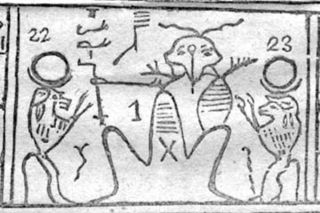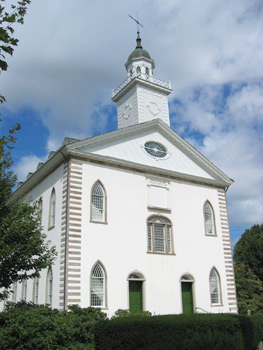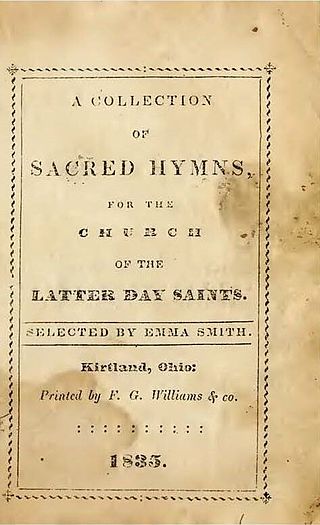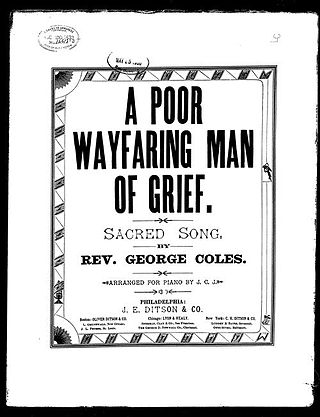Related Research Articles

In the Latter Day Saint movement, the term ordinance is used to refer to sacred rites and ceremonies that have spiritual and symbolic meanings and act as a means of conveying divine grace. Ordinances are physical acts which signify or symbolize an underlying spiritual act; for some ordinances, the spiritual act is the finalization of a covenant between the ordinance recipient and God.

Kolob is a star or planet described in the Book of Abraham, a sacred text of the Latter Day Saint movement. Several Latter Day Saint denominations hold the Book of Abraham to have been translated from an Egyptian papyrus scroll by Joseph Smith, the founder of the movement. According to this work, Kolob is the heavenly body nearest to the throne of God. While the Book of Abraham calls Kolob a "star", it also calls planets "stars", and therefore some Latter Day Saint commentators consider Kolob a planet. The body also appears in Latter Day Saint culture, including a reference to Kolob in an LDS hymn.

The Kirtland Temple is a temple of the Community of Christ, formerly the Reorganized Church of Jesus Christ of Latter Day Saints, located in Kirtland, Ohio, United States. It is the first temple built by adherents of the Latter Day Saint movement and was designed by Joseph Smith, the founder and original leader of the movement. The design mixes the Federal, Greek Revival, and Gothic Revival architectural styles. It has been a National Historic Landmark since 1969.

William Wines Phelps was an early leader of the Latter Day Saint movement. He printed the first edition of the Book of Commandments that became a standard work of the church and wrote numerous hymns, some of which are included in the current version of the Church of Jesus Christ of Latter-day Saints' hymnal. He was at times both close to and at odds with church leadership. He testified against Joseph Smith, providing evidence that helped persuade authorities to arrest Smith. He was excommunicated three times and rejoined the church each time. He was a ghostwriter for Smith. Phelps was called by Smith to serve as assistant president of the church in Missouri and as a member of the Council of Fifty. After Smith's death, Phelps supported Brigham Young, who was the church's new president.

A Collection of Sacred Hymns, for the Church of the Latter Day Saints. was the first hymnal of the Latter Day Saint movement. It was published in 1835 by the Church of the Latter Day Saints.
"Adam-ondi-Ahman" is an LDS hymn and was included in the first Latter Day Saint hymnal and quickly became one of the most popular songs of the early church. It was published in 1835 in Messenger and Advocate and is hymn number 49 in the current LDS Church hymnal.

"Christ the Lord Is Risen Today" is a Christian hymn associated with Easter. Most of the stanzas were written by Charles Wesley, and the hymn appeared under the title "Hymn for Easter Day" in Hymns and Sacred Poems by Charles and John Wesley in 1739. The hymn eventually became well known for the "Alleluia" sung as a melisma after each line, which was added by an unknown author, probably to fit the commonly used hymn tune, "Easter Hymn". It remains a traditional processional hymn on Easter Sunday.
In the Latter Day Saint movement, a hosanna shout is an organized ritual of a congregation shouting "hosanna". It was first performed as a ritual in the dedication of the Kirtland Temple, and was a part of the Kirtland endowment ceremony. It continues to be practiced by some Latter Day Saint denominations, most notably the Church of Jesus Christ of Latter-day Saints, which practices the ritual at the dedication of each of its temples and other important buildings.
Hymns are an important part of the history and worship of the Church of Jesus Christ of Latter-day Saints.

Hymns of the Church of Jesus Christ of Latter-day Saints is the official hymnal of the Church of Jesus Christ of Latter-day Saints . Published in English in 1985, and later in many other languages, it is used throughout the LDS Church. This article refers to the English version. The book was published on the 150th anniversary of the publication of the first LDS hymnbook, compiled by Emma Smith in 1835. Previous hymnbooks used by the church include The Manchester Hymnal (1840), The Psalmody (1889), Songs of Zion (1908), Hymns (1927), and Hymns (1948).

"Come, Come, Ye Saints" is one of the best-known Latter-day Saint hymns. The lyrics were written in 1846 by Mormon poet William Clayton. The hymn has been called the anthem of the nineteenth-century Mormon pioneers.
"We Thank Thee, O God, for a Prophet" is a hymn of the Church of Jesus Christ of Latter-day Saints. It has been sung at many general conferences of the LDS Church since it was published in 1863.
A solemn assembly is a formal and sacred procedure in the Church of Jesus Christ of Latter-day Saints conducted to give added emphasis to the purpose of the occasion. Solemn assemblies are held at the dedications of temples and for specially-called meetings to provide instruction to church leaders. Solemn assemblies are also held for the purpose of sustaining a new church president, who church members consider to be a prophet, seer, and revelator. Such assemblies are held, in particular, to follow the law of common consent. In 1831, a year after Joseph Smith established the Church of Christ, church members believe he was instructed by revelation to "call your solemn assembly, that your fastings and your mourning might come up into the ears of the Lord of Sabaoth." Historically, solemn assemblies were held on special occasions of major religious importance in ancient Israel.

"A Poor Wayfaring Man of Grief" is a seven-stanza poem written in 1826 by James Montgomery. The words of the poem have since been adopted as a Christian hymn.
In the theology of the Latter Day Saint movement, an endowment refers to a gift of "power from on high", typically associated with the ordinances performed in Latter Day Saint temples. The purpose and meaning of the endowment varied during the life of movement founder Joseph Smith. The term has referred to many such gifts of heavenly power, including the confirmation ritual, the institution of the High Priesthood in 1831, events and rituals occurring in the Kirtland Temple in the mid-1830s, and an elaborate ritual performed in the Nauvoo Temple in the 1840s.
"How Firm a Foundation" is a Christian hymn, published in 1787 by John Rippon in A Selection of Hymns from the Best Authors, Intended to be an Appendix to Dr. Watts's Psalms and Hymns, known as "Rippon's Selection." How Firm a Foundation is number 128 in the 1787 first printing. It is attributed only to "K", which probably refers to Robert Keen(e), precentor at Rippon's church, though other names suggested include Richard or John Keene, Kirkham, John Keith or Words by G. Keith and Music by J. Reading as cited in the 1884 publication of Asa Hull's Jewels of Praise. It is most often sung to the tune "Foundation" which first appeared in A Compilation of Genuine Church Music (1832) edited by Joseph Funk, though the original tune may be Keen(e)'s "Geard".
"Crown Him with Many Crowns" is an 1851 hymn with lyrics written by Matthew Bridges and Godfrey Thring and sung to the tune 'Diademata' by Sir George Job Elvey. The hymn appears in many hymnals.

The following outline is provided as an overview of and a topical guide to the Church of Jesus Christ of Latter-day Saints.
References
- Clothier, Richard (1996), A Heritage of Hymns: an exploration of music and religion, music and our hymns, and the stories of hymns and hymn writers of the Restoration Movement, Independence, Missouri: Herald House, ISBN 0830907378, OCLC 34905979
- Cornwall, J. Spencer (1975) [1961, 1963], Stories of Our Mormon Hymns, Salt Lake City: Bookcraft, OCLC 6639608
- Davidson, Karen Lynn (2009) [1988], Our Latter-day Hymns: the Stories and the Messages (Revised ed.), Salt Lake City, Utah: Deseret Book, ISBN 9781606410684, OCLC 297222576
- Hicks, Michael (Spring 1985), "Poetic Borrowing in Early Mormonism", Dialogue: A Journal of Mormon Thought , 18 (1): 132–142, doi:10.2307/45225330, JSTOR 45225330, S2CID 254336974